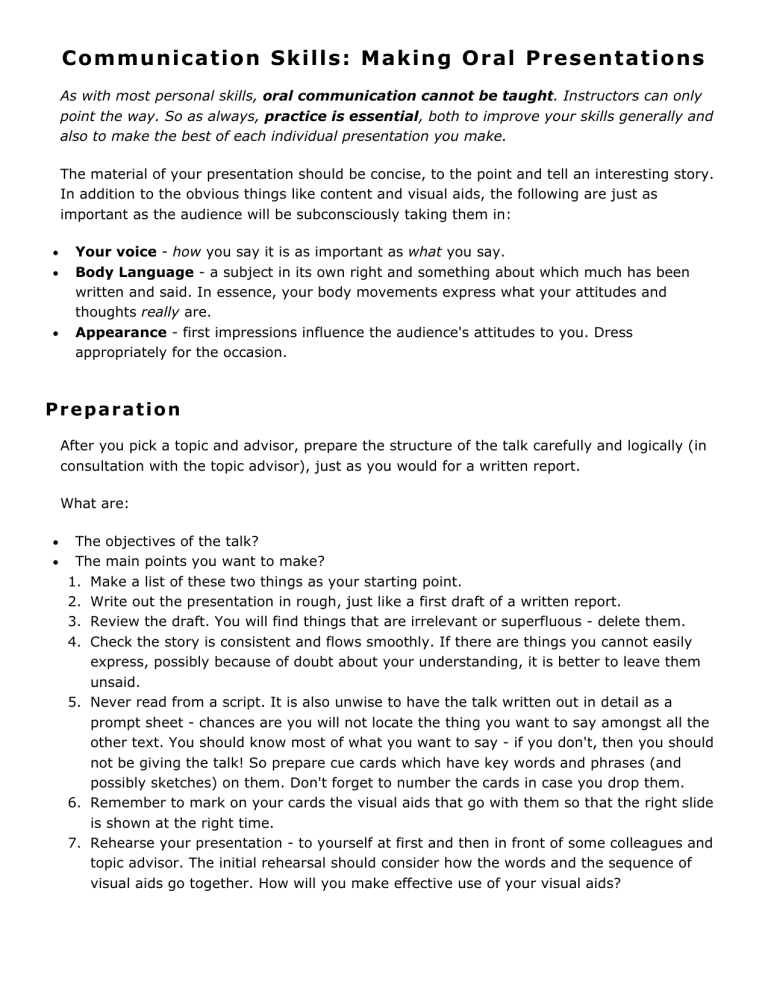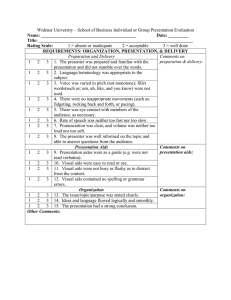
Communication Skills: Making Oral Presentations As with most personal skills, oral communication cannot be taught. Instructors can only point the way. So as always, practice is essential, both to improve your skills generally and also to make the best of each individual presentation you make. The material of your presentation should be concise, to the point and tell an interesting story. In addition to the obvious things like content and visual aids, the following are just as important as the audience will be subconsciously taking them in: Your voice - how you say it is as important as what you say. Body Language - a subject in its own right and something about which much has been written and said. In essence, your body movements express what your attitudes and thoughts really are. Appearance - first impressions influence the audience's attitudes to you. Dress appropriately for the occasion. Preparation After you pick a topic and advisor, prepare the structure of the talk carefully and logically (in consultation with the topic advisor), just as you would for a written report. What are: The objectives of the talk? The main points you want to make? 1. Make a list of these two things as your starting point. 2. Write out the presentation in rough, just like a first draft of a written report. 3. Review the draft. You will find things that are irrelevant or superfluous - delete them. 4. Check the story is consistent and flows smoothly. If there are things you cannot easily express, possibly because of doubt about your understanding, it is better to leave them unsaid. 5. Never read from a script. It is also unwise to have the talk written out in detail as a prompt sheet - chances are you will not locate the thing you want to say amongst all the other text. You should know most of what you want to say - if you don't, then you should not be giving the talk! So prepare cue cards which have key words and phrases (and possibly sketches) on them. Don't forget to number the cards in case you drop them. 6. Remember to mark on your cards the visual aids that go with them so that the right slide is shown at the right time. 7. Rehearse your presentation - to yourself at first and then in front of some colleagues and topic advisor. The initial rehearsal should consider how the words and the sequence of visual aids go together. How will you make effective use of your visual aids? Making the presentation Someone will introduce you and therefore there will not be a need for you to re-introduce yourself. Good presentations then follow this formula: Tell the audience what you are going to tell them, Then tell them, At the end tell them what you have told them. Keep to the time allowed. If you can, keep it short. It's better to under-run than over-run. As a rule of thumb, allow 2 minutes for each general Powerpoint slide you use, but longer for any that you want to use for developing specific points. However, the audience will get bored with something on the screen for more than 5 minutes, especially if you are not actively talking about it. So switch the display off, or replace the slide with some form of 'wallpaper' such as the Plant Sciences Department logo. Stick to the plan for the presentation, don't be tempted to digress - you will eat up time and could end up in a dead-end with no escape! At the end of your presentation ask if there are any questions. If questions are slow in coming, you can start things off by asking a question of the audience so have one prepared. Leave time for discussion - 5 minutes is sufficient to allow clarification of points. The session chairman may extend this if the questioning becomes interesting. Delivery Speak clearly. Don't shout or whisper - judge the acoustics of the room. Don't rush, or talk deliberately slowly. Be natural - although not conversational. Deliberately pause at key points - this has the effect of emphasizing the importance of a particular point you are making. Avoid jokes - always disastrous unless you are a natural expert. To make the presentation interesting, change your delivery, but not too obviously, eg: o speed o pitch Use your hands to emphasize points but don't indulge in too much hand waving. People can, over time, develop irritating habits. Ask colleagues occasionally what they think of your style. Look at the audience as much as possible, but don't fix on an individual - it can be intimidating. Pitch your presentation towards the back of the audience, especially in larger rooms. Don't face the display screen behind you and talk to it. Other annoying habits include: o Standing in a position where you obscure the screen. In fact, positively check for anyone in the audience who may be disadvantaged and try to accommodate them. o Muttering over a transparency on the OHP projector plate and not realizing that you are blocking the projection of the image. o Avoid moving about too much. Pacing up and down can unnerve the audience, although some animation is desirable. Keep an eye on the audience's body language. Know when to stop and also when to cut out a piece of the presentation. Visual Aids Visual aids significantly improve the interest of a presentation. However, they must be relevant to what you want to say. A careless design or use of a slide can simply et in the way of the presentation. What you use depends on the type of talk you are giving. Here are some possibilities: Overhead projection transparencies (OHPs) 35mm slides Computer projection (Powerpoint, applications such as Excel, etc.) Video and film Real objects - either handled from the speaker's bench or passed around Flipchart or blackboard - possibly used as a 'scratch-pad' to expand on a point Keep it simple, though - a complex set of hardware can result in confusion for speaker and audience. Make sure you know in advance how to operate equipment and also when you want particular displays to appear. Edit your slides as carefully as your talk - if a slide is superfluous then leave it out. If you need to use a slide twice, duplicate it. Slides should contain the minimum information necessary. To do otherwise risks making the slide unreadable or will divert your audience's attention so that they spend time reading the slide rather than listening to you. Try to limit words per slide to a maximum of 10. Use a reasonable size font and a typeface which will enlarge well. Typically use a minimum 18pt Times Roman and preferably larger. Use color on your slides but avoid orange and yellow which do not show up very well when projected. For text only, white or yellow on blue is pleasant to look at and easy to read. Books on presentation techniques often have quite detailed advice on the design of slides. If possible consult an expert such as the Audio Visual Center. Room lighting should be considered. Too much light near the screen will make it difficult to see the detail. On the other hand, a completely darkened room can send the audience to sleep. Try to avoid having to keep switching lights on and off, but if you do have to do this, know where the light switches are and how to use them. Finally ... Enjoy yourself. The audience will be on your side and want to hear what you have to say!

